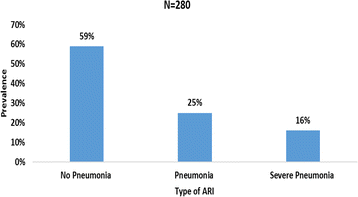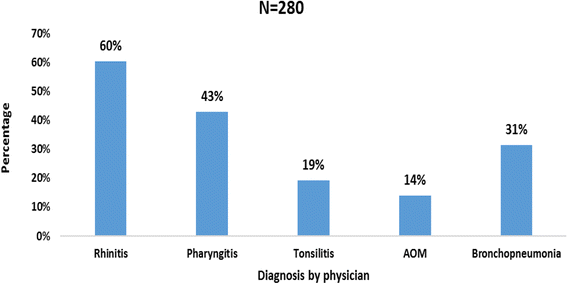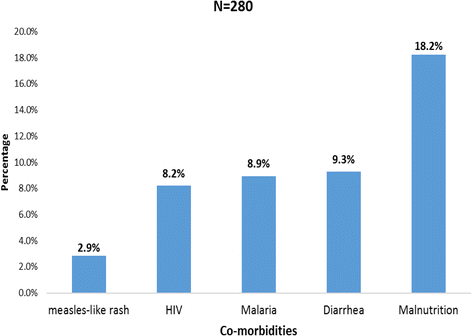Risk factors for acute respiratory infections in children under five years attending the Bamenda Regional Hospital in Cameroon
- PMID: 29338717
- PMCID: PMC5771025
- DOI: 10.1186/s12890-018-0579-7
Risk factors for acute respiratory infections in children under five years attending the Bamenda Regional Hospital in Cameroon
Abstract
Background: Acute respiratory infections (ARI) are a leading cause of morbidity and mortality in under-five children worldwide. About 6.6 million children less than 5 years of age die every year in the world; 95% of them in low-income countries and one third of the total deaths is due to ARI. This study aimed at determining the proportion of acute respiratory infections and the associated risk factors in children under 5 years visiting the Bamenda Regional Hospital in Cameroon.
Methods: A cross-sectional analytic study involving 512 children under 5 years was carried out from December 2014 to February 2015. Participants were enrolled by a consecutive convenient sampling method. A structured questionnaire was used to collect clinical, socio-demographic and environmental data. Diagnosis of ARI was based on the revised WHO guidelines for diagnosing and management of childhood pneumonia. The data was analyzed using the statistical software EpiInfo™ version 7.
Results: The proportion of ARIs was 54.7% (280/512), while that of pneumonia was 22.3% (112/512). Risk factors associated with ARI were: HIV infection ORadj 2.76[1.05-7.25], poor maternal education (None or primary only) ORadj 2.80 [1.85-4.35], exposure to wood smoke ORadj 1.85 [1.22-2.78], passive smoking ORadj 3.58 [1.45-8.84] and contact with someone who has cough ORadj 3.37 [2.21-5.14]. Age, gender, immunization status, breastfeeding, nutritional status, fathers' education, parents' age, school attendance and overcrowding were not significantly associated with ARI.
Conclusion: The proportion of ARI is high and is associated with HIV infection, poor maternal education, exposure to wood smoke, passive cigarette smoking, and contact with persons having a cough. Control programs should focus on diagnosis, treatment and prevention of ARIs.
Keywords: Acute; Proportion; Respiratory infections; Risk factors; Under-five.
Conflict of interest statement
Ethics approval and consent to participate
This study was approved by the Institutional Review Board of the Faculty of Health Sciences, University of Buea, Cameroon. Participants were not exposed to any risk by taking part in the study. Parents or guardians signed a written informed consent form, as approval for their children to be participants.
Consent for publication
Not applicable.
Competing interests
The authors declare that they have no competing interests.
Publisher’s Note
Springer Nature remains neutral with regard to jurisdictional claims in published maps and institutional affiliations.
Figures
Similar articles
-
Acute respiratory infection related to air pollution in Bamenda, North West Region of Cameroon.Pan Afr Med J. 2019 Mar 4;32:99. doi: 10.11604/pamj.2019.32.99.15228. eCollection 2019. Pan Afr Med J. 2019. PMID: 31223389 Free PMC article.
-
The epidemiology of acute respiratory infections in children and adults: a global perspective.Epidemiol Rev. 1990;12:149-78. doi: 10.1093/oxfordjournals.epirev.a036050. Epidemiol Rev. 1990. PMID: 2286216 Review.
-
Maternal knowledge, attitude and practices regarding childhood acute respiratory infections in Kumasi, Ghana.Ann Trop Paediatr. 1994;14(4):293-301. doi: 10.1080/02724936.1994.11747732. Ann Trop Paediatr. 1994. PMID: 7880091
-
Environmental burden of acute respiratory infection and pneumonia due to indoor smoke in Dhading.J Nepal Health Res Counc. 2010 Apr;8(1):1-4. J Nepal Health Res Counc. 2010. PMID: 21879004
-
Indoor air pollution in developing countries and acute respiratory infection in children.Lancet. 1989 Feb 25;1(8635):427-9. doi: 10.1016/s0140-6736(89)90015-9. Lancet. 1989. PMID: 2563799 Review.
Cited by
-
Environmental risk factors associated with respiratory diseases in children with socioeconomic disadvantage.Heliyon. 2021 Apr 22;7(4):e06820. doi: 10.1016/j.heliyon.2021.e06820. eCollection 2021 Apr. Heliyon. 2021. PMID: 33997379 Free PMC article.
-
Prevalence of and factors associated with childhood diarrhoeal disease and acute respiratory infection in Bangladesh: an analysis of a nationwide cross-sectional survey.BMJ Open. 2022 Apr 6;12(4):e051744. doi: 10.1136/bmjopen-2021-051744. BMJ Open. 2022. PMID: 35387807 Free PMC article.
-
Respiratory virus surveillance in hospitalized children less than two-years of age in Kenema, Sierra Leone during the COVID-19 pandemic (October 2020- October 2021).PLoS One. 2023 Oct 10;18(10):e0292652. doi: 10.1371/journal.pone.0292652. eCollection 2023. PLoS One. 2023. PMID: 37816008 Free PMC article.
-
Ecological zone and symptoms of acute respiratory infection among children under five in Ghana: 1993-2014.SSM Popul Health. 2019 Jun 3;8:100414. doi: 10.1016/j.ssmph.2019.100414. eCollection 2019 Aug. SSM Popul Health. 2019. PMID: 31206003 Free PMC article.
-
Trends and determinants of acute respiratory infection symptoms among under-five children in Cambodia: Analysis of 2000 to 2014 Cambodia demographic and health surveys.PLOS Glob Public Health. 2023 May 3;3(5):e0001440. doi: 10.1371/journal.pgph.0001440. eCollection 2023. PLOS Glob Public Health. 2023. PMID: 37134089 Free PMC article.
References
-
- WHO . Pneumonia, the forgotten killer of children. Geneva 27: UNICEF/WHO; 2006.
-
- The UN Inter-agency Group for Child Mortality Estimation . Levels & Trends in Child Mortality: Report 2014. New York: UNICEF; 2014.
-
- Organization WH, UNICEF. Ending preventable child deaths from pneumonia and diarrhoea by 2025: the integrated global action plan for pneumonia and diarrhoea (GAPPD). 2013. - PubMed
MeSH terms
Substances
LinkOut - more resources
Full Text Sources
Other Literature Sources
Medical




